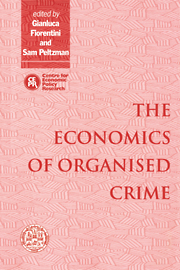Book contents
- Frontmatter
- Contents
- List of figures
- List of tables
- Foreword
- Acknowledgements
- List of conference participants
- 1 Introduction
- PART I THEORIES OF THE STATE AND THE ORIGIN OF CRIMINAL ORGANISATIONS
- PART II THE CRIMINAL ORGANISATION AS A FIRM
- PART III ORGANISED CRIME AND STATE INTERVENTION IN THE ECONOMY
- PART IV DETERRENCE POLICIES AGAINST LEGAL FIRMS INVOLVED IN ILLEGAL ACTIVITIES
- 8 Auditing with ‘ghosts’
- Discussion
- 9 The reputational penalty firms bear from committing criminal fraud
- Discussion
- PART V DETERRENCE POLICIES AGAINST ORGANISED CRIME
- Index
Discussion
Published online by Cambridge University Press: 04 August 2010
- Frontmatter
- Contents
- List of figures
- List of tables
- Foreword
- Acknowledgements
- List of conference participants
- 1 Introduction
- PART I THEORIES OF THE STATE AND THE ORIGIN OF CRIMINAL ORGANISATIONS
- PART II THE CRIMINAL ORGANISATION AS A FIRM
- PART III ORGANISED CRIME AND STATE INTERVENTION IN THE ECONOMY
- PART IV DETERRENCE POLICIES AGAINST LEGAL FIRMS INVOLVED IN ILLEGAL ACTIVITIES
- 8 Auditing with ‘ghosts’
- Discussion
- 9 The reputational penalty firms bear from committing criminal fraud
- Discussion
- PART V DETERRENCE POLICIES AGAINST ORGANISED CRIME
- Index
Summary
The paper by Cowell and Gordon deals with tax evasion by firms. The model considers three kinds of firms: honest firms; diversifying firms, i.e. partial tax evaders who file unfaithful reports; and ‘ghosts’, i.e. firms that do not file any tax report and totally submerge in response to the auditing policy. The presence of endogenous ghosts is the novelty which reverses some of the conventional wisdom on tax auditing strategies. Under these circumstances, sophisticated cut-off rules can be dominated by simple random audit. As the authors suggest, this means ‘that it may sometimes be optimal for the tax authority not to use all available information’.
I believe that the paper is empirically relevant and theoretically interesting, even if the analysis could be improved by taking into account more complex strategies.
Let us begin with the empirical relevance. Evidence from a large country like Italy suggests that ghosts are alive and kicking. The existing studies of the submerged sector show that ghosts can account for 10–20 per cent of GDP. They are particularly likely to proliferate in sectors with small firms in direct contact with consumers, and high fertility and mortality rates of firms. Whenever the national accounts have been revised, submerged firms accounted for a great part of the revision itself.
A recent, and most unfortunate, revision of the auditing strategy in Italy supports the view that ghosts are endogenous. In the 1992 fiscal year, to reduce partial evasion of small businesses, firms had to report at least a minimum income, pay taxes and then incur a long and tiresome bureaucratic effort to demonstrate their income was lower than the threshold.
- Type
- Chapter
- Information
- The Economics of Organised Crime , pp. 197 - 198Publisher: Cambridge University PressPrint publication year: 1996



